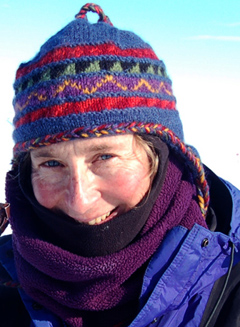Christine Siddoway facts for kids
Quick facts for kids
Christine Siddoway
|
|
|---|---|
 |
|
| Born | December 26, 1961 |
| Nationality | American |
| Other names | Christine Helen Smith, Christine H. Smith, Christine Smith Siddoway |
| Alma mater | BSc Carleton College, 1984 MSc University of Arizona, 1987 PhD University of California-Santa Barbara, 1995 |
| Awards | Fellow of the Geological Society of America Member of Sigma Xi, the Scientific Research Honor Society Antarctic Service Medal |
| Scientific career | |
| Fields | Structural geology Tectonics |
| Institutions | Colorado College |
Christine Siddoway is an American scientist. She is well-known for her important work in Antarctica. She studies the Earth's rocks and how they move and change over time. This field is called geology and tectonics. Her research helps us understand the history of our planet, especially in cold places like Antarctica.
She has made discoveries about ancient ice ages. She also found clues about how big the West Antarctic Ice Sheet was in the past. These clues came from rocks carried by ice into the Amundsen Sea.
Contents
Early Life and Education
Christine Siddoway started her college studies at Carleton College. She earned her first degree there in 1984.
She then went on to get her master's degree in 1987. This was from the University of Arizona. Later, she studied at the University of California, Santa Barbara. She completed her PhD there in 1995.
Her PhD research focused on a special type of rock formation. It was the only known gneiss dome in Antarctica. This dome is found in the Fosdick Mountains.
Exploring Earth's History in Antarctica
Christine Siddoway has spent a lot of time doing field research. She has worked in Antarctica for 12 seasons since 1989. Her work helps us understand how the Earth's crust changes.
Understanding Rock Formations
Early in her career, she studied rocks in Marie Byrd Land. She wanted to know how deep rocks from the Earth's middle crust came to the surface. She found that these rocks moved up quickly. This happened because of a process called "transtension." It involves rocks pulling apart and sliding sideways at the same time.
Her research helped explain how gneiss domes form. These are dome-shaped rock structures. The Fosdick Mountains gneiss dome became a key example for this process. Her studies showed how this landmass became stable within Antarctica.
Mapping Antarctica's Past
In 2009, Siddoway helped start the SCAR ANTscape project. This project helped scientists map Antarctica's bedrock. Knowing the shape of the land beneath the ice is important. It helps us understand how the Antarctic ice sheet formed and changed.
More recently, she worked on Antarctic GeoMap. This project creates detailed geological maps of Antarctica. It helps scientists around the world share information.
Funding Important Research
The National Science Foundation in the U.S. has supported Siddoway's work. She has received many grants over more than 20 years.
One big project was the ROSETTA-Ice Project. She worked with other scientists, many of whom were women. They studied the Ross Ice Shelf and the Ross Embayment. They used special equipment from planes and on the ground. This project helped them learn about the ice shelf's structure.
Research in the Rocky Mountains
Besides Antarctica, Siddoway also studied the Front Range of the Colorado Rocky Mountains. Her work there led to an interesting discovery. She found the age of certain sandstone rocks. These rocks were found inside granite.
This research helped explain the age of "The Great Unconformity" in Colorado. This is a huge gap in the rock record. It shows a long period of missing geological time.
Current Research Projects
As of 2025, Christine Siddoway is involved in several projects. She is studying how ice sheets interact with heat from deep inside the Earth. She is also part of the International Ocean Discovery Program. This program explores the history of the West Antarctic Ice Sheet by studying ocean sediments.
She continues to research ancient sedimentary records. These records help us understand the supercontinent Rodinia. She also studies tiny fossils and rocks carried by ice. This helps test ideas about past ice sheet collapses.
Serving the Scientific Community
Siddoway has also helped lead important scientific groups. She served on committees for the Geological Society of America. She also helped organize international meetings about Antarctic Earth sciences.
Awards and Honors
Christine Siddoway has received several awards for her contributions.
- In 2003, she was given the Antarctic Service Medal. This award recognizes people who have done important work in Antarctica.
- She was elected a fellow of the Geological Society of America in 2009. This is a high honor for geologists.
- In 2021, she became a member of Sigma Xi, the Scientific Research Honor Society.
- She also received a Fulbright Post-doctoral Research Fellowship in Italy in 1995.

